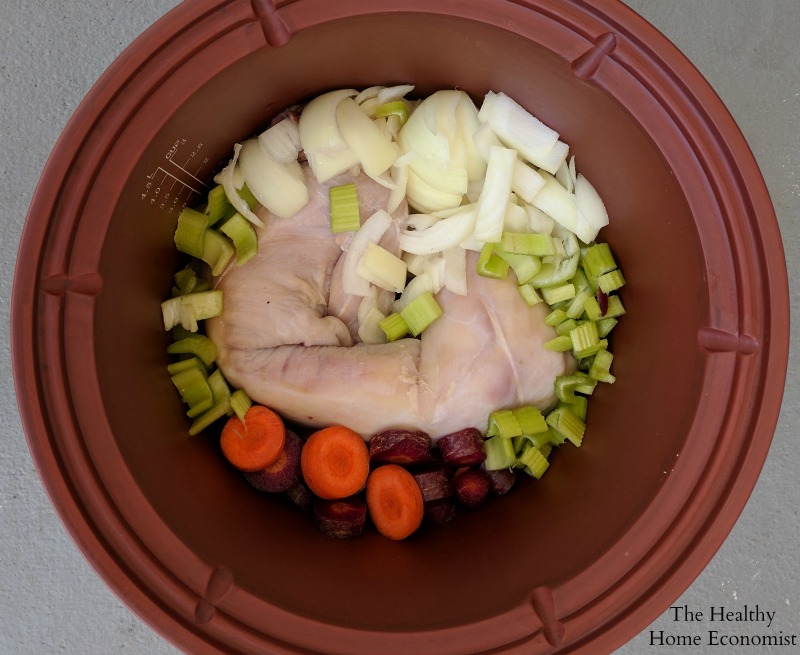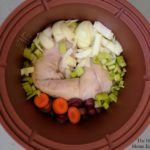
Rabbit is not a very popular meat in the United States. In Europe, however, it is commonplace with numerous traditional recipes in German, French and Italian cuisine. Where there are rabbit recipes, there is also rabbit bone broth as our forebears frugally used the whole animal for food. This was in keeping with the 1546 proverb, “Willful waste makes woeful want” and a similar saying first recorded in 1772, “Waste not want not“.
The popularity of rabbit as an environmentally friendly meat source is causing a significant change, however. Rabbit, which is all white meat, is starting to gain some serious traction on North American dinner plates.
Easy to raise, butcher and prepare, rabbits don’t need large tracts of land upon which to roam and graze. The average sized rabbit produces 6 pounds of meat on the same amount of food and water it takes a cow to produce 1 pound!
We all know that rabbits reproduce, well, like rabbits! They’re ready to eat in 10 weeks and super tasty too (like chicken!).
For these reasons, rabbit is becoming more widely available where just a few years ago you couldn’t find them anywhere unless you raised them yourself. In my local area, for example, rabbit is regularly available at both of the butcher shops closest to my home.
Rabbit Bone Broth
If your family absolutely won’t eat rabbit, the best way to ease them into acceptance is with rabbit bone broth. It tastes just like chicken bone broth, and so you can use it for all your soup and sauce recipes.
Once the kids have seen Mom or Dad buy rabbit a few times and make broth with it, they will be more open to eating it. This recipe for rabbit Moroccan hot pot is an easy one to try first when you get to that point.
Below is a recipe for basic rabbit bone broth. Try it! While not the most nutritious bone broth made from fish, you will be amazed how inexpensive rabbit stock is to make compared with pastured chicken broth while tasting essentially the same with a similar nutritional profile.
This article on simmering bone broth shows the perfect roll that isn’t too high and isn’t too low. Also, if your broth doesn’t properly become a semi-solid once refrigerated, refer to this guide on the 5 most common reasons broth won’t gel.
If you are sensitive to monosodium glutamate, I would recommend reading this article on MSG in bone broth.
Best Cookware for Bone Broth
As you can see from the photo above, I use a large, 4.5 quart Vita-Clay to make my bone broth. I prefer a clay pot to a stockpot or a pressure cooker because of the acidity of bone broth, which has the potential to leech nickel and excessive chromium from stainless steel. This article on stainless steel cookware explains the research studies that give rise to this very real concern.
Another benefit of using a slow cooker like the Vita-Clay (which is periodically offered in stoneware as well as clay) is that you can leave it gurgling while you leave the house. It’s also safe and eliminates the fire danger from a simmering pot on the stovetop while the household is asleep at night.

Rabbit Bone Broth Recipe
Easy recipe for rabbit stock that is frugal and compares favorably in flavor to broth from pastured chickens or grassfed beef.
Ingredients
- 1 whole rabbit preferably pastured, innards removed
- filtered water
- 2-3 Tbl apple cider vinegar preferably raw, organic and packed in glass bottles
- 3 cups chopped vegetables preferably onion, carrots, and celery
Instructions
-
Place whole rabbit and vegetables in a large pot and fill with filtered water.
-
Stir in vinegar while bringing the water to a gentle boil.
-
As the water first begins to boil, skim off any foam that rises to the surface. It is important to remove this foam as this is impurities and off flavors.
-
Reduce heat to a simmer for 24 hours.
-
Cool and then strain into containers for refrigeration.
-
Freeze what you will not use in one week.








Hi! This may sound like a strange question but do you eat the veggies and meat after you cook it? It says to strain it so it sounds like you don’t? I’m assuming most of the good stuff in the meat is in the broth. Could you let me know? I’d love to try this dish but don’t want to waste! Thank you!
The veggies and meat are quite tasteless after being simmered for so long. All the minerals have been cooked out into the broth. You can blend into a soup if you like or toss. The meat is good for a chicken salad type dish (made with rabbit meat of course).
Sarah, I love your site and look forward to updates whenever I received them. You have helped me thru some difficult times when my health wasn’t its best. So thank you. I am 74 years old and when I grow up I want to be like you. LOL Thank you again Sarah you are a darling. From a Canadian Grandma who loves life.
Wow, that is so nice of you to say Lorraine! Thank you 🙂
What is whole “rabbit starvation”. I read this in the blood on May 17,2017.?
My family’s from Spain, and we raise rabbits in the States. Rabbit is also easy to purchase there everywhere. No problem historically with rabbit starvation, especially when you think of all the other fatty things Spanish love to eat- olive oil, pork, pork, did I mention pork. We love to fry it like chicken. Eat it in a sauce. Stew it. No end to this clean, and really affordable and easy to raise source of protein. Thanks for letting others know it is a great option for people to consider.
I thought rabbit should not be eaten because of the whole “rabbit starvation”. Do you think it’s fine Sarah as long as you eat enough others fat?
As long as it’s not a primary source of food, it should be fine.
Pinterest is saying that your site doesn’t allow Pins (when I try to Pin this). I have Pinned your things before. Any ideas?
There is a bug somewhere. The social sharing company is looking into it. Hopefully will get this fixed within a day or so. Sorry for the inconvenience.
Thanks Sarah! I see Vita Clay has a new 6 qt. one. I have been thinking of purchasing that if it makes good broth. Have you tried the 6 qt. one yet?
The 6 quart one is what I have. Not sure why it says 4.5 quart inside the pot but the model says 6 quart. Maybe because the pot holds 6 quarts, but you only fill to the 4.5 quart line to leave some room at the top??
Do you prefer to use the Vita Clay to make all of your bone broths? I have the Vita Clay but have never used it to make bone broth. I am wondering if you able to bring it to a boil i n the Vita Clay to remove the scum before you simmer it for the 24 hours? If so, what are your steps? Thanks so much!
Yes, I now use a Vita-Clay to make all my bone broths. This is a fairly recent occurrence over the past year and a half or so. I got my first Vita-Clay late in 2015. I now have 3 of them (large, small, and medium sized)!! The large one you just put on high and it brings the broth to a boil fairly quickly, then skim and turn down to low, put on the lid and simmer.
Nice to see you write about rabbit Sarah! I live in Belgium and you can get French rabbit here in every supermarket. And you know what, it’s cheap meat! I understand why now, thanks to your blog.
We like to make rabbit stew with dried plums in the winter months. We let it simmer slowly and eat it with carrots and pureed potatoes.
That sounds delicious!
Oh my gosh, that sounds delicious! My grandparents, from Berlin, ate rabbit weekly. I’m now raising my own. Wonderful creatures and very delicious too! Our ancestors were onto something! Thank you!
To quote the creator of the rabbit, it falls under the category of unclean, Lev. 11:6. The rabbit has a very enlarged caecum. In order for it to obtain sufficient nutrients from the plants it eats, it has to ferment the material requiring a fermentation chamber with an alkaline environment. Since a rabbit does not have a pre-stomach, like a cow, it has to use it’s enlarged caecum. However it’s caecum is sandwiched between it’s gut and rectum where most of the absorption of nutrients takes place. When the rabbit re-digests this material it becomes coprophagous, in other words it eats it’s own excrement. Consequently the level of toxins in its tissues is far higher than in other herbivores. Bile salts, gases and amonia levels are all at unacceptable levels for human consumption. Rodents and even horses fall into the same category. Yes God is all wise, forego eating this creature.
Thank you for sharing Sarah.
My grandfather lived to 85 raising and eating rabbit all his life. A family tradition of ours, but its also nice to see other recipes too! Will try